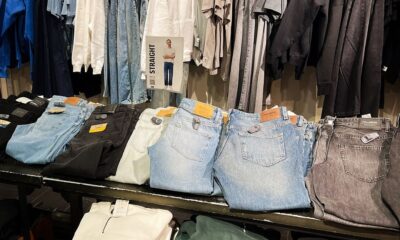Fashion
Milan Fashion Week to open on Tuesday in Giorgio Armani’s shadow

Translated by
Nicola Mira
Published
September 19, 2025
On Tuesday, a fashion world still in mourning will be gathering in Milan for the start of womenswear fashion week. Giorgio Armani, who passed away on September 4, will be in everyone’s hearts. Especially on the evening of Sunday September 28, when the iconic Italian label will stage its runway show, the final event of the fashion week dedicated to the Spring/Summer 2026 women’s ready-to-wear collections. The show will be held in the main courtyard of Palazzo Brera and will feature the last creations by ‘King Giorgio’. It will also fête the 50th anniversary of Armani’s eponymous label, and is clearly set to be the crowning event of this emotion-filled week.
The Italian luxury label has confirmed that the week’s closing show will go ahead, as will the double show scheduled for its young line Emporio Armani on Thursday September 25, and the exhibition dedicated to Armani at the Pinacoteca di Brera gallery, featuring 150 looks from the Armani archives. “We will celebrate [Milan] Fashion Week by paying tribute to one of its founders, Giorgio Armani, and to his creative, entrepreneurial and personal legacy, so valuable in this transformation period the fashion industry is going through,” said Carlo Capasa, president of the Italian Fashion Chamber (CNMI), presenting what promises to be an intense Milan Fashion Week programme.
Between September 23 and 29, Milan will host 171 events, including 54 in-person shows, the same number as in February. In addition, four digital shows are scheduled at the end of the week, on Monday 29, by Maxivive and by rookie labels Mein Corp by Italian designer Lorenzo Sala, Nadya Dyzak, a Ukrainian label launched in 2008, and Zenam, the label by Cameroonian designer Paul Tanonkou, which previously featured on the menswear calendar.
The calendar includes 10 new names, between emerging labels and previous participants (like Milano Moda Graduate, the collective show by the city’s fashion academies), compensating for 10 absentees. While Giorgio Armani is no longer with us, after dominating the fashion scene for half a century, this week Milan is welcoming his successors, between emerging talents, several comebacks, and new creative directors who have taken charge at some major labels.
The first is Demna (Gvasalia) at Gucci, who will unveil his first looks for the Kering group’s premier label in a presentation scheduled on Tuesday September 23. Dario Vitale, taking his first steps at Versace after the latter was recently acquired by the Prada group, will adopt the same understated format on September 26.
On Wednesday September 24, it will be Simone Bellotti’s turn to debut for Jil Sander, while Louise Trotter will unveil her first collection for Bottega Veneta on Saturday 27 – the label is back on the Milan Fashion Week calendar after skipping the February edition. Another highlight will be Fendi’s co-ed show on Wednesday 24, overseen by Silvia Venturini Fendi, celebrating the Roman house’s centenary one last time. FashionNetwork.com has learnt that one of the show’s surprise guests may be French mezzo-soprano Axelle Saint-Cirel, singing six arias with harp accompaniment.

An event worth keeping an eye on will be the maiden Milanese show by British ready-to-wear label Knwls, scheduled on Wednesday September 24. The London-based label, a favourite among celebrities, has gone from strength to strength in recent years, thanks to its sensual Y2K silhouettes and its focus on female empowerment. Knwls was launched in 2017 by British designer Charlotte Knowles with her partner, Canadian Alexandre Arsenault. In 2022, Knwls was an LVMH Prize finalist, and it is available at over 50 leading multibrand retailers worldwide.
A major debut is scheduled on Friday September 26, with the first runway show by Sa Su Phi, a womenswear label set up in 2021, during the pandemic, by Sara Ferrero, an experienced finance executive, and Susanna Cucco, design expert and creative consultant, whose eponymous agency has been collaborating with many top labels in the course of over 25 years. Having begun with luxury knitwear, they have developed a minimalist, sophisticated and timeless style, winning over some 70 top retailers worldwide.
Milan Fashion Week will also welcome comebacks by the likes of Boss, Calcaterra, The Attico and Stella Jean, which have all given Milan a miss in recent seasons, as well as Anglo-Nigerian designer Ineye Tokyo James. After staging his rookie show in Milan in February 2022, James dropped below the radar before coming back in March with a digital show. Also back is Vietnamese designer Phan Dang Hoang, who debuted in Milan in September 2024, and then failed to return. Indian designer Dhruv Kapoor and Pierre-Louis Mascia, who had both featured on the men’s calendar until January, are now included in the womenswear programme.
Another 14 new names will feature on the presentation calendar, including young French designer Henri Paris with his sophisticated creations, Davii, Daizy Shely, Forte_Forte, Îacaré, Kasai, Moja Rowa, Nissa, Pé de Chumpo, Saman Loira, Seafarer, Simon Cracker, which usually shows in the menswear week, Vespa and JW Anderson, which has also scheduled an event at its newly renovated store. Trussardi too is making a comeback, releasing a short film starring Eva Herzigova and Fernando Lindez at the Anteo cinema on September 28.

Versace and Gucci are among the dropouts from this edition’s runway show calendar, having opted instead for a presentation, as mentioned above. Also off the show calendar are Marni and Bally, both going through a transition phase in terms of style, with Marni’s new creative director Meryll Rogge set to show in Milan next February – while Fiorucci has moved to a slot in the menswear week in June. The other absentees are Swedish label Avavav, which had been showing in Milan since September 2023, Susan Fang, which showed in March supported by Dolce & Gabbana, Philipp Plein, K-Way and Dsquared2.
Milan Fashion Week will, as always, be able to count on several top Italian names, among others Prada, Moschino, Roberto Cavalli, Ferragamo, Dolce & Gabbana, Etro and Max Mara, as well as on a plethora of off-calendar events. The first is the Maestri d’Eccellenza Prize, recognising Italy’s top artisans, sponsored by Thélios and LVMH with CNMI and Confartigianato, Italy’s national artisanal association. The award ceremony is scheduled on September 23.
Kering will play its part with Cinemoda Club, a fashion-related film festival sponsored by the French luxury group with Vogue Italy and scheduled on September 25-27, and S|Style, a focus on sustainable emerging labels, including Jeanne Friot from France, on September 26-28. Also on the programme, the third edition of the Black Carpet Awards on September 24, the CNMI Sustainable Fashion Awards (the sustainable fashion prize set up by CNMI in 2017) on September 27, as well as several new store openings within Milan’s luxury shopping district, with cocktail parties and gala evenings galore.
Copyright © 2025 FashionNetwork.com All rights reserved.
Fashion
CFDA to implement fur ban at NYFW from September 2026
Fashion
ECB keeps interest rates unchanged, upgrades growth outlook

According to updated Eurosystem staff projections, headline inflation is expected to average 2.1 per cent in 2025, easing to 1.9 per cent in 2026 and 1.8 per cent in 2027, before returning to 2.0 per cent in 2028. Inflation excluding energy and food is forecast at 2.4 per cent in 2025, gradually declining to 2.0 per cent by 2028. Inflation for 2026 has been revised upward, mainly due to expectations that services inflation will fall more slowly than previously anticipated, the Governing Council of the ECB said in a press release.
European Central Bank has kept its key interest rates unchanged, maintaining confidence that inflation will stabilise at the 2 per cent target.
Updated projections show inflation easing gradually over the coming years, with a slight upward revision for 2026 due to persistent services prices.
Economic growth forecasts have been revised higher, supported by stronger domestic demand.
The ECB also revised its economic growth outlook higher compared with its September projections. Growth is now expected to reach 1.4 per cent in 2025, 1.2 per cent in 2026 and 1.4 per cent in 2027, with expansion projected to remain at 1.4 per cent in 2028. The improvement is driven largely by stronger domestic demand across the euro area.
The Council reiterated its commitment to ensuring that inflation stabilises sustainably at the 2 per cent target. It emphasised that future monetary policy decisions will remain data-dependent and assessed on a meeting-by-meeting basis, without pre-committing to any specific interest rate path.
Fibre2Fashion News Desk (KD)
Fashion
US brand Vera Bradley posts net revenue of $62.3 million in Q3

Vera Bradley reported Q3 net revenues of $62.3 million, down from $70.5 million year over year.
Direct revenues fell 5.3 per cent, with comparable sales down 5.8 per cent, while indirect revenues dropped 30.2 per cent.
Gross margin declined to 42.1 per cent, impacted by inventory write-downs and higher duties, despite early progress from its Project Sunshine transformation.
Source link
-

 Business6 days ago
Business6 days agoHitting The ‘High Notes’ In Ties: Nepal Set To Lift Ban On Indian Bills Above ₹100
-

 Politics1 week ago
Politics1 week agoTrump launches gold card programme for expedited visas with a $1m price tag
-

 Business1 week ago
Business1 week agoRivian turns to AI, autonomy to woo investors as EV sales stall
-

 Sports1 week ago
Sports1 week agoPolice detain Michigan head football coach Sherrone Moore after firing, salacious details emerge: report
-

 Fashion1 week ago
Fashion1 week agoTommy Hilfiger appoints Sergio Pérez as global menswear ambassador
-

 Business1 week ago
Business1 week agoCoca-Cola taps COO Henrique Braun to replace James Quincey as CEO in 2026
-

 Sports1 week ago
Sports1 week agoU.S. House passes bill to combat stadium drones
-

 Tech1 week ago
Tech1 week agoGoogle DeepMind partners with UK government to deliver AI | Computer Weekly



















